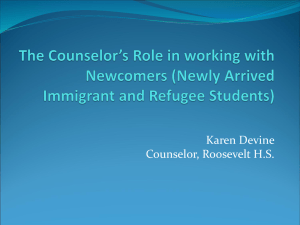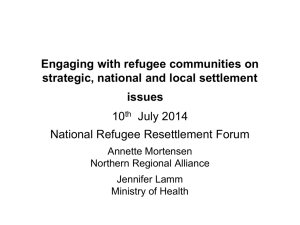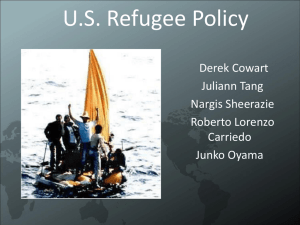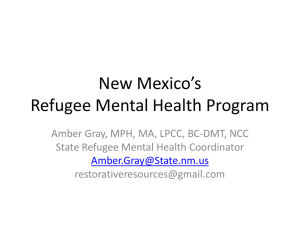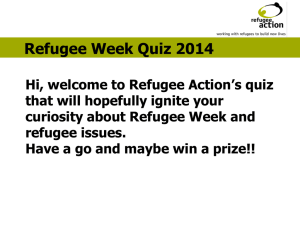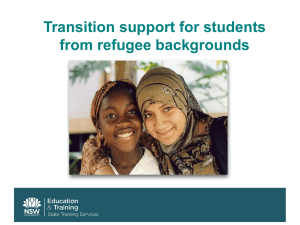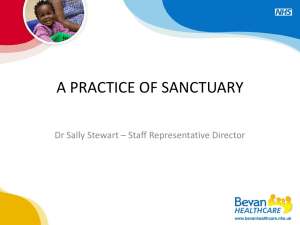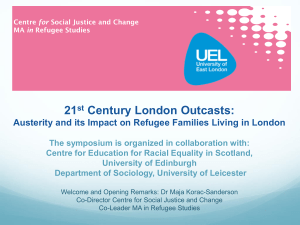Mater Presentation - Greater Metro South Brisbane Medicare Local
advertisement
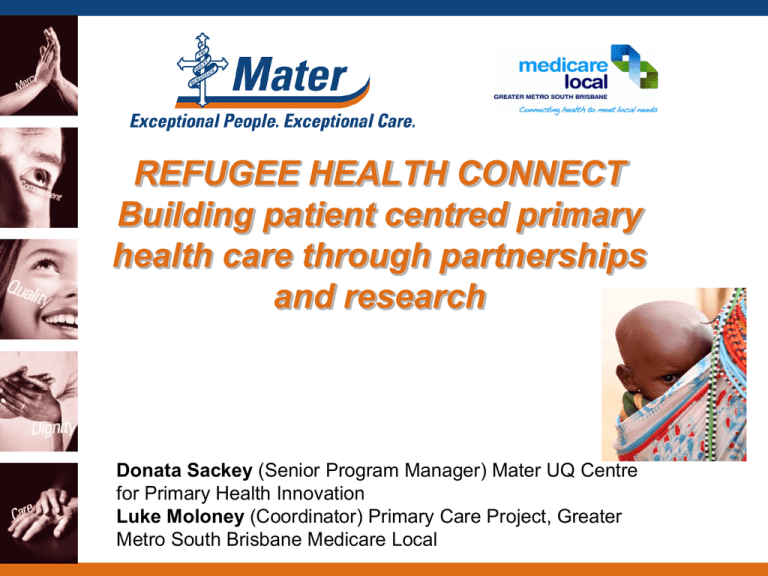
REFUGEE HEALTH CONNECT Building patient centred primary health care through partnerships and research Donata Sackey (Senior Program Manager) Mater UQ Centre for Primary Health Innovation Luke Moloney (Coordinator) Primary Care Project, Greater Metro South Brisbane Medicare Local Background and context • Between 2000 and 2014, Australia has permanently resettled approximately 200,000 people from refugee and humanitarian backgrounds from Africa, Middle East and South Asia Background and context • It is well documented that people from refugee backgrounds experience difficulties in accessing health services due to cultural and linguistic barriers. • Primary health care is the best setting for the delivery of timely and quality health care and assessments. Background and context • Qld has no state-wide refugee health care model and no refugee health policy. • APHCRI funded study (2010-12) – identified key components for a best practice model of refugee health care delivery. • MHS and GMSBML in partnership with key stakeholders are implementing an innovative, evidence based model of care for new arrivals in the Brisbane South area The Model -partnerships • PAG (Partnerships Advisory Group) includes 22 organisations across Gold Coast, Logan, Brisbane North and South including academic and community representatives, HHS, MLs, clinicians and settlement. • CAG (Clinical Advisory Group) provides clinical leadership and resource development. Chaired by GMSBML clinical lead. • Mental Health Working Group with a focus on developing resources and capacity in primary care and reports to PAG • Community Advisory Group – G8 (MHS) project The Model: Refugee Health Connect • Refugee Health Connect: o referral facilitation of new arrivals to Brisbane South based at GMSBML with close collaboration with Mater Integrated Refugee Health Service and MDA. o Building capacity in primary care through a “Beacon” model using Tier 1 practices to provide refugee health assessments and care. o In practice support (clinical leads GP/nurse) for Tier 2 practices o Practice systems support to build sustainability o Close collaboration with settlement services and support to build health system knowledge. Refugee Health– A new mode for delivering primary health care . Tier 1 Practices Provides: Reduces: Specific Measurable Achievable Realistic Time appropriate Barriers to care Service duplication Gaps in service provision Communication errors Care Cross-sector collaboration Outcomes Focused Enlists collective strengths Ensures sustainability Enhances communication Facilitates ICT Integration Provides Initial Health Assessments Provides Care for Complex Cases Determines Best Practice Guidelines Enhances capacity Facilitates Engagement Distributes Best Practice Guidelines Enables Advocacy Supports teaching and education Up-skills GPs with special interest Linkage with General Practice: Advisory body Aligned Primary Care Organisations • Summary of Current Care Stakeholders with a Shared Vision Partnership Advisory Group • Formal education of multi-disciplinary team Clinical Advisory Group Other Health Care Providers • Practice staff /Nurse/ GP/ Allied Health • Knowledge of resources in local community • Informal guidance General Practice Tier 2 Underpinned by Research Provides data for planning of interventions Provides evidence for best practice Evaluates needs of communities and providers Evaluates effectiveness of interventions General Practice Tier 2 General Practice Tier 2 Underpinned by Community Engagement Refugee Health Connect Mater Refugee Health Advisory Group Outcomes • RHC: facilitated 447 new referrals between JanOct 2014 (100% of all new arrivals to Brisbane South). • Four Tier 1 practices providing health assessments and with agreements with MHS for colocation of refugee health nurses/ data sharing • Resources: online Mental Health Referral tool, immunisation hints and tips, recommended pathology Outcomes • Two peer research projects (ethics approved) RaPH and Youth research • Three education events per annum on diverse topics including: mental health, Hepatitis, TB What next? • Evaluation of the Brisbane Sth model – quantitative and qualitative approach – evaluation plan, data set and ethics • Using a co-creation approach – a patient centred model with a participant research framework • Opportunities to expand the peer led research projects What next? • Collection of prevalence data • Multi-site (Tier 1 practices and other refugee health services – Logan – Brisbane North) • National approach – APHCRI – development of a national evaluation framework – partnerships with Monash, UNSW, RHeaNA • Qualitative – Refugee communities (peer led interviews – focus groups) – Health providers (interviews) • Empowerment of community members through health literacy – Women as Health Leaders project Benefits of our approach • • • • Priorities are negotiated and agreed Quality enhanced and not dependent on funding Findings are translated Dissemination – System – Providers – Communities • Enhanced capacity within the communities, clinicians (and others) • Less research waste Aknwoledgements • Dr Margaret Kay (UQ) • Dr Ignacio Correa-Velez (QUT) • Caroline Nicholson and Paula Peterson (MHS) • Andrea Vancia and Sylvia Penhaligon (GMSBML) • Chris Allotta and MIRHS Team (MHS) • The communities and all key stakeholders THANK YOU
